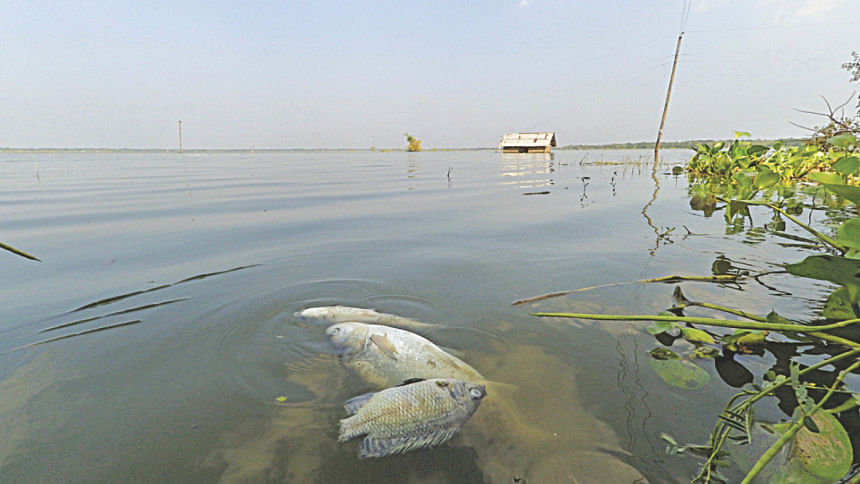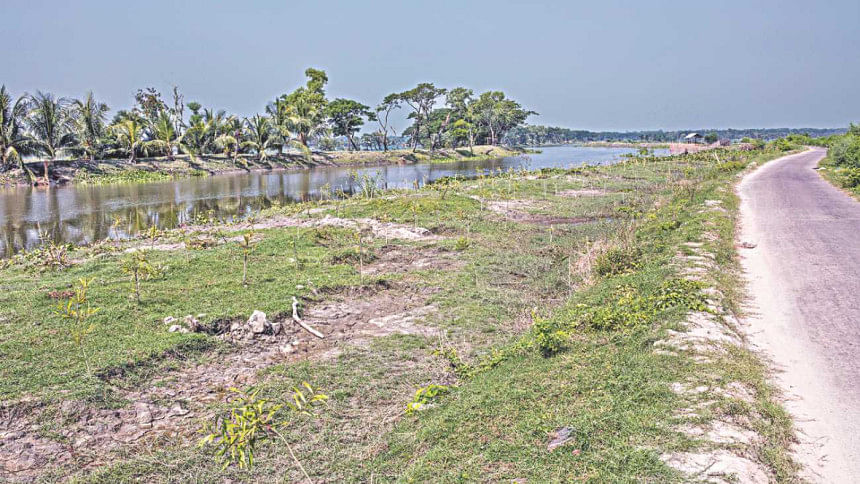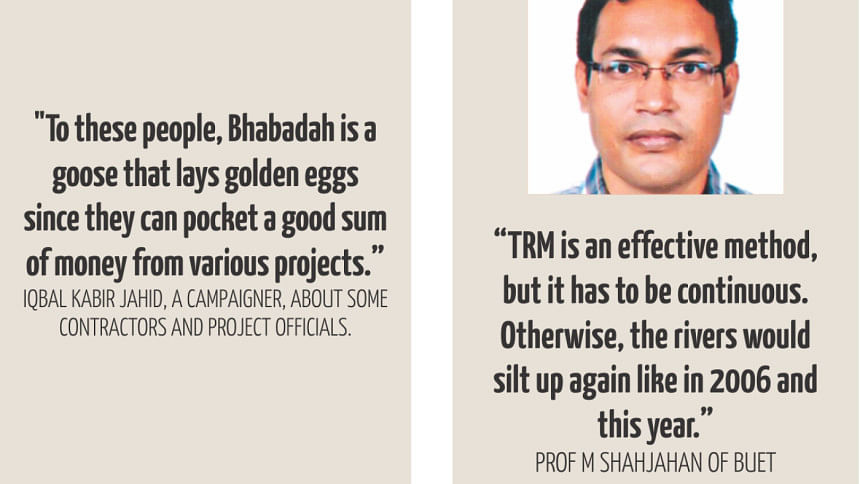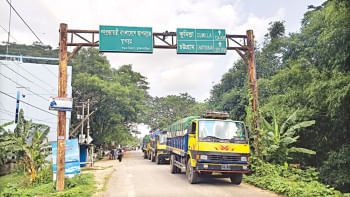Sorrow of Jessore: Remedy is there

Bhabadah, often called the “Sorrow of Jessore”, where water is a symbol of suffering, hunger, disease, and death. The perennial waterlogging triggered from Bhabadah point affects mainly three upazilas -- Abhaynagar, Manirampur and Keshabpur -- home to some 10 lakh people. This year, almost six lakh inhabitants were affected when the flood situation was at its worst during the rainy season. Five months later, things have improved but many farmers won't still be able to grow crops. But what's the cause of Bhabadah's woes? Is there no solution? There is. Why is it not happening then? In this two-part story [the last part today], WASIM BIN HABIB and TUHIN SHUBHRA ADHIKARY chronicle Bhabadah's saga at a time when, with much of the vast land still under this year's floodwaters, many beel people are wondering how they will prepare for the next rain.
After most of the Bhabadah rivers silted up, things turned real bad in 1983. Several villages and much of the low-lying area went under water after a heavy rain. It was the worst waterlogging since the embankments were built in the 1960s, and the water stagnation lasted several months.
As a quick solution, people opened channels in the embankments. They hoped, firstly, the waters would drain out to the rivers, and secondly, flooding rivers would leave sediments and raise the beel floor every year, which won't go under water easily.
It worked. The stagnated water gushed out to the rivers. Within weeks the navigability of the rivers improved.
Locals called their indigenous water management system “Joaradhar” (a place for tidal waters), which has now come to be officially known as Tidal River Management (TRM).

Between 1983 and 1997, the people living in beel areas used this technique in Singair Beel, Dahuri Beel and Beel Dakatia. The waterlogging problems improved in the areas.
The government in 1997 adopted TRM as a viable solution and decided to apply it in all the beels in phases. The waterlogging situation improved a lot even after partial implementation of TRM until 2013 (except for 2005-06). Rains during this period flooded the farmlands but did not enter homes.
But influential locals, especially the shrimp hatchery (gher) owners were dead against this plan. Also, some flaws in the TRM projects created rifts among the locals.
FATE SEALED BY MAN
People of Bhabadah often blame their fate for their sufferings and call this God's “punishment”. But their fate, if it has anything to do with waterlogging, has been sealed by man.
In the 1990s, a phenomenal growth in the numbers of shrimp ghers or hatcheries in the beels took up most of the lands. Each of these beels has about 40 percent of khas land. Today, most of these lands “belong” to shrimp owners. They have also managed, sometimes by force or trickery, to lease hundreds of acres of private land from farmers.
“They are locally influential and have political links,” said Probir Kumar Goshwami, executive engineer at the Water Development Board (WDB) in Jessore.
Information on the exact size of the shrimp business there is not available, but locals say it's a multi-million dollar business a year.
"Since the ghers involve a lot of money, owners often obstruct government projects," said Iqbal Kabir Jahid, a campaigner and also politburo member of the Workers Party of Bangladesh.
The cancellation of a TRM project in Beel Kapalia is a prime example of their money and muscle power.
The project was launched on May 1, 2012. On June 2, parliament Whip Sheikh Abdul Wahab went to the area to inaugurate a peripheral embankment, only to come under an attack by gher owners and their goons. The whip's car was set on fire and his men were beaten up. The attack forced the government to initially suspend and then eventually cancel the project in 2015 for "complexity and slow implementation."
Some project officials and contractors also benefit from the delay because it means more money, locals alleged.
"The problem has been kept alive for decades because it serves the interest of some corrupt government officials and influential people," said Jahid.
"To these people, Bhabadah is the proverbial goose that lays golden eggs. Governments change, but the faces of power do not," he said.
Consider Khulna-Jessore Drainage Rehabilitation Project (KJDRP), one of the biggest projects taken up to address river drainage and waterlogging problem in the entire southwest region, including Bhabadah.
The Tk 272-crore project implemented between 1995 and 2004 included massive dredging work, construction of regulators, dams and embankments. But the project did more harm than good. The drainage system in the region worsened and several rivers died, The Daily Star found in 2006 when Bhabadah had the worst ever waterlogging.
The project failed because it did not consider TRM as a solution to the waterlogging problem, said Ranjit Kumar Bawali of Dumurtola in Abhaynagar, convener of the Sangram Committee.
He has been campaigning for a solution ever since the problem began.

In 1997, the WDB finally included the TRM system in the project, first applying it in Beel Bharat Bhayena in Keshabpur and in Beel Kedaria in 2002. There was a relief from waterlogging in these two beels.
But Beel Kedaria's TRM project stopped in 2005 after gher owners, led by BNP leader Nazmus Sadat, wrote to the district administration, saying their croplands were being damaged by the water entering the beels through the openings.
But in fact, they did it to protect their ghers, campaigners say.
Sadat claimed that people were against the project as they did not get due compensation for land acquisition.
In 2006, the WDB introduced the TRM project in Beel Khukshia in Keshabpur under a project and decided to apply it in other beels.
The project was not implemented in the entire beel area and people living outside the embankments were waterlogged.
The project dragged on for an extra four years after the completion date of 2008 and farmers could not grow any crops. Besides, more than a fourth land owner didn't get the promised compensation due to procedural flaws. So, agitated people closed the cut-point of the TRM in January 2013, bringing an end to the project.
Even though such resentment contributed to the project failure, the gher owners were the main stumbling block to the TRM project in Beel Kapalia. Until recently, they had the full backing of former Manirampur upazila chairman Shawpan Bhattacharjee, now an independent lawmaker.
"There was no deadline for the TRM projects. Compensation was uncertain and poor. Considering all this, I was with the protesters [gher owners],” said the Jessore-5 MP. "But as the government has now met all these conditions, we all want implementation of TRM projects."
Due to such rifts, politics and influence of the gher owners, the WDB did not implement any TRM or river dredging projects until last year except for an emergency excavation project, said an official at the WDB in Jessore, preferring to remain unidentified.
This year's waterlogging worsened because the 21-vent sluice gate at Bhabadah point had to be shut for a month for the Tk 1.7-crore project. But around 15km of riverbed of the Hari silted up even more because of lost flow from the beel. So when the rain came, it could not hold the waters, locals say.
THE REMEDY
This new crisis seems to have patched up the rifts somewhat. Locals, political leaders, government officials, campaigners and independent experts all agree that TRM, if implemented in a cyclic, planned manner, is the answer to this problem. Even some gher owners now privately admit this.
"TRM is an effective method, but it has to continue. Otherwise, the rivers would silt up again like in 2006 and this year,” said Prof M Shahjahan Mondal of the Institute of Water and Flood Management at the Buet.
But he warned that although TRM would bring some immediate respites, it should not be seen as a permanent solution.
“The authorities should also continue river dredging every year and maintain the sluice gates,” said Shahjahan, who visited the area in late October.
Probir Kumar Goshwami, executive engineer at the WDB in Jessore, agrees, but says, "If we want to keep the rivers and canals active, we have to excavate around 90km of the river network up to Shibsha river round the year, which is extremely expensive."
Asked about the alleged corruption by some officials, he said he could not comment about the past. But there is no scope for corruption since 2011, when a new mechanism was devised to fight corruption.
Early this year, the government decided to implement TRM in Beel Kapalia. As part of the project, a survey is now looking into how to implement TRM more effectively.
But the actual work won't begin in another year, according to officials.
That will mean another year of misery for Hari Chand Mandal or anyone else in these beels. Caught up in this trap called Bhabadah, they have lived with waters for much too long. They want a solution before the next rain.

 For all latest news, follow The Daily Star's Google News channel.
For all latest news, follow The Daily Star's Google News channel. 



Comments